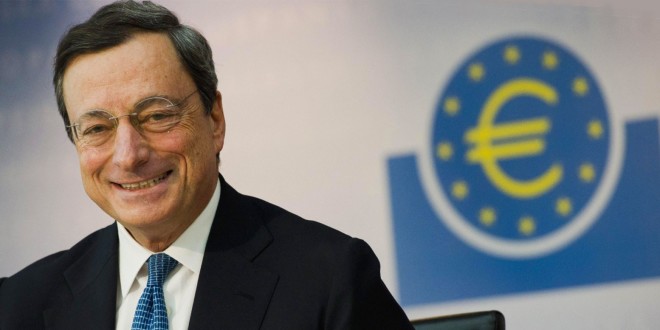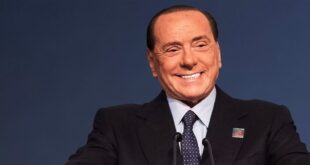In 2012, Mario Draghi, President of the European Central Bank, said he would do “whatever it takes” to claim his commitment to save the Eurozone. Four years later, he seems to have delivered the promise, if not exceeded it. Greece is still in the single currency bloc, Spain and Ireland are expected to grow at around 3 and 4 percent next year, respectively, while the euro-area economy has not fallen into deflation and is projected to reach its 2% inflationary goal by 2019. The resilience and boldness of Mario Draghi, in implementing extensive measures and using all the available monetary loosening instruments, despite frequent German opposition, makes him stand out as a reassuring figure truly committed to the European project—an increasingly rarer feature among Union leadership.
Draghi’s battle horse has been Quantitative Easing (QE), the practice of buying large-scale government bonds in order to inject liquidity in the banking sector, with the effect of increasing credit supply and lowering interest rates, ultimately making loans more affordable. In March 2016, the ECB has extended its purchase program for asset-backed securities and covered bonds from €60 billion to €80 billion per month till March of 2017. Before QE, loans to SME’s contracted at a yearly rate of 2,9%, but since 2015 loans increased. It is estimated that without QE growth would currently be 1% lower.
Along with QE, Draghi has taken steps to further cut the deposit rates by 10 basis points leading interest rates down to -0.4%. This means the ECB will be charging banks more to hold their money overnight, with the aim of encouraging them to lend it to businesses so as to increase aggregate demand and inflation. This measure has received backlash by the German finance minister Shauble and Bundesbank, the ECB’s largest shareholder, worrying that the plans would hurt German pension schemes (since pensioners tend to save more). Yet, Draghi has been bold in stating his willingness to take even greater measures for the wellbeing of other Eurozone countries such as Italy and Spain which have suffered more severely from programs of budgetary restraint and structural readjustments, while continuing to have the lowest credit ratings and high interest rates on state bonds.
Under Draghi’s mandate the ECB has also adopted the 3-year Long-Term Refinancing Operations (TLTROs) mechanism as further monetary loosening tool allowing larger loans to be taken out by requesting banks, by extending the time period (from 6 months to 3 years) for which those ECB loans should be repayed. This has had the effect of actually decreasing the interest rates and risk associated to state bonds, which are used as collateral for repaying the loans. This shows Draghi’s flexible monetary policy stance in order to lubricate the rusty European machine by incentivizing bank lending to the real economy and allow debt repayments to be less of a hassle.
While the transition mechanisms between banks and investors remain seemingly petrified and the desired 2% inflationary goal is still far to reach, it is key to highlight the importance of the monetary stimulus which has provided substantial support to the euro area recovery. As Draghi says:
“Without these measures, the euro area would have been in outright deflation last year and prices would have fallen at an even quicker pace this year. Growth would have been significantly lower.”
The ECB boss has also shown to be farsighted by trying to strengthen the centralization of monetary banking policy to arrive to a more communal European solution of “risk-reduction through risk sharing”. Along with the European Commission, Draghi has implemented the Single Resolution Mechanism to increase supervisory action towards banks and ensure a consistent application of the Bank Recovery and Resolution Directive’s (BRRD’s)—aimed at regulating more efficiently loan bail-ins of national banks (until now made by national governments at tax payer expense for billions of euros). Accordingly, Draghi plans to adopt a Single Resolution Fund aimed at ensuring a uniform administrative practice in the financial resolution for failing credit institutions. These measures are a further endorsement of Draghi’s colossal efforts aimed at secure the banking union and trying to give a stronger direction to the ECB.
However, to appreciate more fully the degree of Draghi’s performance it is important that we take into consideration the obstacles and limitations he faces.
The first is that the banking union is architecturally incomplete. As Draghi acknowledged in an interview on October 25th: “We should not lose sight of the fact that if the monetary union is not finished”. Further, while the ECB can act in moments of crisis, its influence thereafter is limited by political decisions of elected member states representatives. While Draghi can verbally urge countries to act, he does not have the power to impose fiscal discipline. This is because the ECB is structured around a German model of central banking that allows it to operate only to maintain price stability, while preventing it from pursuing the objectives of high employment and business cycle stabilization—as characterized instead by the Anglo-Saxon model.
The ECB also faces restrictions of political nature, namely with the adoption of the European Fiscal Compact ratified by most EU governments in the wake of the Greek debt crisis. For Martin Wolf, commentator on the Financial Times, this policy decision has been instead the to blame for the prolonged stagnation, aggregate unemployment and disinflation that characterizes today’s European climate. He criticizes the unsustainability of such fiscal rigor which has not only failed at reducing public deficits but has further restricted the ability of EU countries (already limited by the Maastricht Treaty) to apply structural reforms and create internal job market flexibility. All this projects the Eurozone in the worrisome territory of disinflation, reflecting a persistent and endemic investor/consumer pessimism—even with close to 0% interest rates people seem to be paradoxically hoarding money.
In spite of such an unfavorable economic climate—further undermined by Brexit, Russian sanctions and lowering Chinese growth—and considering the limited operational tools of the ECB, Draghi has nonetheless managed to substantially keep the euro afloat and prevent a European banking crisis from taking larger proportions. Still, the fate of euro area remains in the hands of national governments, above all Germany whose austere economic policy is being increasingly questioned—Nobel Prize winner Thomas Piketty has even defined it as “short-sighted and selfish”.
The Eurozone is in desperate need of fiscal policy reorientation that should be more overt and in line with the ECB directives. This is the position taken also by OECD in its recent Economic Outlook arguing that to exit the current “low-growth trap” all EU countries “must take a more expansionary stance”. Draghi has loudly spoken about the need to coordinate such fiscal and monetary efforts to create the necessary conditions for cyclical recovery, increase aggregate productivity and competition of ‘southern’ European states. Inactivity is no longer an option and European leftist leaders must follow a path of change, partly already traced by Draghi. However, with upcoming popular referendums (in Italy) and presidential elections (in Germany and France), it seems unlikely that national governments are willing to make radical amendments to their economic agendas anytime soon, especially with populist movements ramping in the polls.






